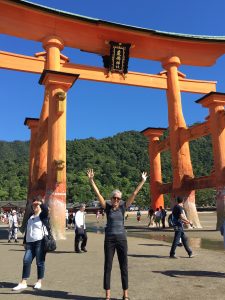Just 25 minutes away from the city center of Hiroshima lies an island just offshore that is a sacred Shito site since ancient times. With a surface area of 11.6 sq miles, it is forbidden either to be born or to die there, so there is no maternity hospital or cemetery on the island. Named an UNESCO World Heritage Site, the beaches, forest, hiking trails and freely roaming deer make it a tourist attraction, even without the special shrines.
A train to Miyajimaguchi brought us to a 10-minute ferry to Miyajima. The island is beautiful, lush, green and hilly, but is best known for the vermilion torii gate that floats in water whenever the tide is in, and is accessible to stand beneath when the tide, the range of which is very long, goes out. Technically the gate to the Itsukushima Shrine, it is this torii which is most photographed by visitors. The shrine itself is also built over water, on short pilings, so at some times of the day it appears to be built in the sea. The famous torii gate is 52 ft high, and made of camphorwood. The fact that it stands offshore is thought to relate to the sacred nature of the island: ordinary people were not allowed to set foot on it and had to approach by sea, through this gate, in order to get to the temple. There are other shrines and temples and a 5 story pagoda, all of which would be extraordinary if I’d seen them before seeing dozens of others in Japan!
Then there was the deer. Again. Only this time there weren’t vendors selling deer food and they simply roamed around, visited the beach and lay among the lanterns along the sea wall. On a walk up to the cable car we came across two separate does with tiny fawns. The one pictured here was still wobbly it was so new. The deer are so accustomed to people that we were able to sit nearby and watch as she licked the baby and the fawn struggled to reach mom to nurse. So very charming.
The ride up to Mt. Misen was on a cable car and then a funicular, and once there it was still a 1km 100m climb to the top. Mt. Misen, where some gods are still believed to reside is said to have been explored by Kobo-daishi, a great teacher of Buddhism in the 8th C, and rises to 1,755 ft. There is a primeval forest which is also considered a World Heritage Site for its diversity of plants and trees. Along the trail were some massive, strange rocks and several temples and halls related to Kobo-daishi. The Reika-do Hall houses the eternal flame, lit about 1,200 years ago. Part of the flame was used to light the eternal flame at the A-bomb epitaph in Peace Memorial Park. The observation deck at the deck provided an uninterrupted 360 degree view of many islands of the Seto Inland Sea, as well as Hiroshima. Quite stunning.
With the tide out we watched many locals digging for tiny clams and oysters (well known in this part of Japan and offered in all forms), and even caught what I think was a sea eagle in flight over the bay. It was a beautiful day, and so we ended as we began with a ferry and train ride back to our hotel. Tomorrow we move on once again, as the Japan part of this grand adventure is almost complete.














